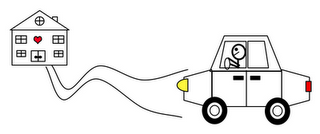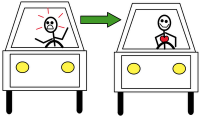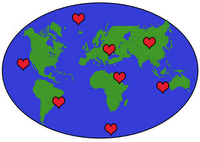Neuroplasticity: Changing our Belief about Change
 A dangerous belief in our culture is that we can't change. We’ve all heard the disempowered statements: “He’s just grumpy. He can’t change that.” or “I will always be anxious. It's the way I was born.” While we most certainly have genetic predispositions, the brains of individuals’ young and old can change in amazing ways.
A dangerous belief in our culture is that we can't change. We’ve all heard the disempowered statements: “He’s just grumpy. He can’t change that.” or “I will always be anxious. It's the way I was born.” While we most certainly have genetic predispositions, the brains of individuals’ young and old can change in amazing ways.
 Our brain can also prune old neural pathways to quiet or unlearn associations. For example, after you move to a different home, you learn the directions to your new place and stop practicing your old path. But in those first few weeks after a move, have you ever found yourself engrossed in another thought and accidentally pulling into the driveway of your old home because your automatic pathway took over? Luckily, by refraining from the old directions and practicing the new way home, you strengthen a new neural pathway and the old neural pathway weakens. It's a good thing our brains can change, or we would still be pulling up to our childhood home.
Our brain can also prune old neural pathways to quiet or unlearn associations. For example, after you move to a different home, you learn the directions to your new place and stop practicing your old path. But in those first few weeks after a move, have you ever found yourself engrossed in another thought and accidentally pulling into the driveway of your old home because your automatic pathway took over? Luckily, by refraining from the old directions and practicing the new way home, you strengthen a new neural pathway and the old neural pathway weakens. It's a good thing our brains can change, or we would still be pulling up to our childhood home. Keeping in the car motif, let’s talk about an emotional association: traffic and anger. When we get stuck in traffic, an automatic response can be anger or frustration. But, by feeling angry every time we are in traffic, we are strengthening that neural pathway and cementing that emotional response. When there is nothing we can do in that moment but accept the traffic, wouldn’t it be great to feel positive emotions instead? We can just observe the negative emotion that we are feeling and try practicing a different emotional response. We can start linking traffic with stillness and peace. This would be difficult at first because we want to let the well-developed neural pathway leading to anger fire, but by inhibiting that pathway, we help unwire those connections and strengthen a different response. As we practice responding with peace, we strengthen a new neural pathway and it becomes easier to choose.
Keeping in the car motif, let’s talk about an emotional association: traffic and anger. When we get stuck in traffic, an automatic response can be anger or frustration. But, by feeling angry every time we are in traffic, we are strengthening that neural pathway and cementing that emotional response. When there is nothing we can do in that moment but accept the traffic, wouldn’t it be great to feel positive emotions instead? We can just observe the negative emotion that we are feeling and try practicing a different emotional response. We can start linking traffic with stillness and peace. This would be difficult at first because we want to let the well-developed neural pathway leading to anger fire, but by inhibiting that pathway, we help unwire those connections and strengthen a different response. As we practice responding with peace, we strengthen a new neural pathway and it becomes easier to choose. Gratitude reflections, compassion priming, and meditation interventions are some strategies found to enhance well-being and increase prosocial behavior. Several studies have shown the positive impact of gratitude journals, which involve self-guided listing of what you are thankful for. Individuals who kept a daily gratitude journal reported higher levels of positive emotions, including feeling attentive, determined, energetic, enthusiastic, excited, interested, joyful, and strong, compared to individuals who kept a journal on daily hassles or ways in which one was better off than others (downward social comparison). In addition, individuals who maintained daily gratitude journals were more likely to offer emotional support to others and help someone with a problem7. Contemplative interventions, born from the collaboration of meditation traditions and emotion science, have centered on developing mindfulness to enhance compassion and happiness in the lives of individuals. One recent study provided an 8-week training program in secular meditation to female schoolteachers and measured their responses to stress, conflict, and compassion. The intervention significantly reduced rumination, depression, and anxiety while increasing mindfulness, empathy, compassion, and stabilizing hostility and contempt compared to a control group6.
Gratitude reflections, compassion priming, and meditation interventions are some strategies found to enhance well-being and increase prosocial behavior. Several studies have shown the positive impact of gratitude journals, which involve self-guided listing of what you are thankful for. Individuals who kept a daily gratitude journal reported higher levels of positive emotions, including feeling attentive, determined, energetic, enthusiastic, excited, interested, joyful, and strong, compared to individuals who kept a journal on daily hassles or ways in which one was better off than others (downward social comparison). In addition, individuals who maintained daily gratitude journals were more likely to offer emotional support to others and help someone with a problem7. Contemplative interventions, born from the collaboration of meditation traditions and emotion science, have centered on developing mindfulness to enhance compassion and happiness in the lives of individuals. One recent study provided an 8-week training program in secular meditation to female schoolteachers and measured their responses to stress, conflict, and compassion. The intervention significantly reduced rumination, depression, and anxiety while increasing mindfulness, empathy, compassion, and stabilizing hostility and contempt compared to a control group6. Neuroscience, positive psychology, and contemplative traditions have given us a roadmap. We know our brains can change based on our environment and our behaviors. What if we started building and reinforcing the neural pathways of love, cooperation, forgiveness, and kindness so that these things became our automatic response? What if we adopted and shared this belief that we can change and took responsibility for our outlook on life? What if we taught children in schools about their ability to reflect on and guide their emotions? What if we started priming those around us in our families and community with our own grateful reflections and kind actions? What if our compassionate actions in schools, families, and communities started shifting our culture? I find these possibilities exhilarating and hopeful. By learning and practicing these positive emotional responses, I think our world can discover a new way home and pull into the driveway of compassion.
Neuroscience, positive psychology, and contemplative traditions have given us a roadmap. We know our brains can change based on our environment and our behaviors. What if we started building and reinforcing the neural pathways of love, cooperation, forgiveness, and kindness so that these things became our automatic response? What if we adopted and shared this belief that we can change and took responsibility for our outlook on life? What if we taught children in schools about their ability to reflect on and guide their emotions? What if we started priming those around us in our families and community with our own grateful reflections and kind actions? What if our compassionate actions in schools, families, and communities started shifting our culture? I find these possibilities exhilarating and hopeful. By learning and practicing these positive emotional responses, I think our world can discover a new way home and pull into the driveway of compassion.This article is posted here with permission from the author. Joanna Holsten blogs at "Let's Live Nice,"which documents her journey towards a more critically compassionate life, exploring ideas and actions for a world with less suffering and more happiness. Previous articles by Joanna on DailyGood: Stepping out of the Should Trap and Training the Mind to Find Happiness
SHARE YOUR REFLECTION
13 Past Reflections



On Apr 30, 2012 Noor a.f wrote:
That is what I look all but to get it is hard. how can the three be found? thank you too.

On Apr 29, 2012 Janaki wrote:
what my mind is thinking its the same thing written here.....what if ; if the world have only happiness and love and sacrifice....no more wars and worries,,,,,meditation really works ...thanx a lot

On Apr 25, 2012 Noor a.f wrote:
well, for he who justify ones dependency with plasticity is noble. but thinking a donkey is rebelling against his owner is not wise-am the donkey. affirmative actions are in place should you bother to ask what you would like and wait a positive answer. I paid 80 percent of time to cursed compensator/contributors who demand a lot of time. so trust me and say what you would like me to be/to do. thank you
2 replies: Robert, Surabhi | Post Your Reply

On Apr 24, 2012 Bob Collier wrote:
It's interesting that the exploration of this topic is not more prominent in our culture. I was reading about neuroplasticity ten years ago, but I don't often see it given the attention it deserves by mainstream media.

On Apr 23, 2012 Noor a.f wrote:
@DenisKhan:disqus Thank you that very inspiring comment. I have all those qualities. I only fear if there are government issues because all my fields that I believe I mastered were civilian things some very ruthless. I have the ability to entertain congregations or make them love me by impressing them.
While there are some holding on I really don't know but am sure am a man of people whose inner and outer life are as different as a car and plane are.Thank you for this very warm inspirations. earth is ours though what is in it are for all.
Thank you again ,

On Apr 23, 2012 Sateen Sheth wrote:
Great post - a scientific, yet inspiring read for people who want to try to make change in their life, especially habit patterns that feel so hard to change. This makes me feel as though it is possible - I'm inspired to re-start my gratitude journal!

On Apr 23, 2012 DenisKhan wrote:

On Apr 23, 2012 Noor a.f wrote:

On Apr 23, 2012 Ajandary wrote:
I do believe we have the capacity to change our thinking like the article above is stating. Deborah, changes in the caste systems, bullies rising to the top , and other issues that arise under various systems of belief have more to do with individuals not really grasping the concepts of the philosophy or religion the they profess to follow. I do not really understant what you mean by "using brain plasticity to justify ones own dependency on a system....." Jeannette

On Apr 23, 2012 deborah j barnes wrote:
compassion and wealth correlate negatively so as resources drain we are being told it is an internal issue, when the wholke system set up in the fear model needs overhauling. These little essays do not connect enough dots to help people manifest the change. AKA why Buddha mind didn't change caste systems thinking . why Christianity allowed bullies to rise to the top , Muslims and patriarchy, hierarchy...using brain plasticity to justify ones own dependency on a system is really more blame the victim -new tool old tool box.

On Apr 23, 2012 Wally wrote:
I regularly read one of my favorite poems which has been put on a plaque in our den. The title is in essence the message ....."The person who thinks he can "
1 reply: Tricky | Post Your Reply

On Oct 17, 2013 Organic Learning Center wrote:
Wonderfully written! Easily digestible, practical and true to the science. Thank you!!
Post Your Reply